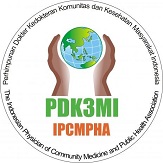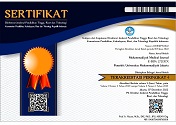Effectiveness of Dhikr Istighfar in Reducing OSCE-Related Anxiety among Medical Students
DOI:
https://doi.org/10.24853/mmj.6.1.1-6Keywords:
anxiety, dhikr istighfar, Objective Structured Clinical ExaminationsAbstract
Background: The prevalence of anxiety among medical students is still relatively high, including in Objective Structured Clinical Examinations (OSCE). This anxiety will have an impact on students' academic achievement. Relaxation techniques can be used to overcome anxiety incidents, and dhikr is a form of relaxation activity. Purposes: This research aimed to determine the decrease in student anxiety about the OSCE exam by dhikr istighfar. Methods: The method used in this research was quasi-experimental research with a pre-posttest and control group design. The research subjects were students of the Muhammadiyah University Palembang first-semester medical study program who would undergo the OSCE block exam and were willing to participate in this research through informed consent. Result: Research data analysis showed that comparison between pretest and posttest for each group also showed significant differences (P < 0.001). It means that dhikr istighfar is significantly effective in reducing students’ anxiety, especially during OSCCE. Conclusion: In conclusion, Dhikr Istighfar may be used as an anxiety management tool in medical education to overcome the anxiety level of students who will take exams, especially OSCE.References
Ströhle A, Gensichen J, Domschke K. The Diagnosis and Treatment of Anxiety Disorders. Dtsch Arztebl Int. 2018 Sep;155(37):611–20.
Bandelow B, Michaelis S. Epidemiology of anxiety disorders in the 21st century. Dialogues Clin Neurosci. 2015 Sep;17(3):327–35.
Parodi KB, Holt MK, Green JG, Porche M V, Koenig B, Xuan Z. Time trends and disparities in anxiety among adolescents, 2012-2018. Soc Psychiatry Psychiatr Epidemiol. 2022 Jan;57(1):127–37.
Mirza AA, Baig M, Beyari GM, Halawani MA, Mirza AA. Depression and Anxiety Among Medical Students: A Brief Overview. Adv Med Educ Pract. 2021;12:393–8.
Kim K-J. Factors associated with medical student test anxiety in objective structured clinical examinations: a preliminary study. Int J Med Educ. 2016 Dec;7:424–7.
Septiawan T, Idris M. The Effect of Dhikr Relaxation Techniques on Stress Level in Hypertension Patients Literature Review. Proc Int Conf Nurs Heal Sci. 2021 Nov 28;2(2 SE-Articles).
Hamsyah F, Subandi S. Dzikir and Happiness: A Mental Health Study on An Indonesian Muslim Sufi Group. J Spiritual Ment Heal. 2016;19(1):80–94.
Hawari D. Al Qur’an Ilmu Kedokteran Jiwa dan Kesehatan Jiwa (Edisi Ketiga). Yogyakarta: PT. Dana Bhakti Prima Yasa; 1997.
Silvitasari, Hermawati I. Pengaruh Spiritual relaksasi terhadap kecemasan mahasiswa menghadapi ujian OSCA di STIKES AISYIYAH Surakarta. Infokes J Ilm Rekam Medis dan Inform Kesehat. 2018 Mar 13;8(1):1–5.
Tasyakuranti AN, Sumarti H, Kusuma HH, Istikomah I, Prastyo IS. Analysis of the Effect of Istighfar Dhikr To Adolescent Anxiety At Beta Wave Activity Using Electroencephalogram (Eeg) Examination. J NeutrinoJurnal Fis dan Apl. 2022;9(1):31–7.
Nugrahati D, Uyun Q, Nugraha S. Pengaruh Terapi Taubat dan Istighfar Dalam Menurunkan Kecemasan Mahasiswa. J Interv Psikol. 2018;10(1):33–41.
Setyowati A, Chung M-H, Yusuf A. Development of self-report assessment tool for anxiety among adolescents: Indonesian version of the Zung self-rating anxiety scale. J Public Health Africa. 2019;10(s1):1172.
Conia PDD, Nurmala MD. Gambaran Tingkat Kecemasan Pada Mahasiswa Penyintas Covid-19 Saat Menghadapi Kembali Proses Pembelajaran. Penelit Bimbing dan Konseling. 2022;7(1):12–20.
Alghifari MM. Studi Kualitatif Kecemasan pada Mahasiswa Kedokteran saat Menghadapi Objective Structured Clinical Examination (OSCE). Nexus Pendidik Kedokt dan Kesehat. 2016;5(2):145–60.
Fidment S. The Objective Structured Clinical Exam (OSCE): A Qualitative Study Exploring the Healthcare Student’s Experience. Student Engagem Exp J. 2012 Jan 26;1(2):711–5.
Ariga RA. Decrease Anxiety among Students Who Will Do the Objective Structured Clinical Examination with Deep Breathing Relaxation Technique. Open access Maced J Med Sci. 2019;7(16):2619–22.
Rafnadila P, Aiyub A, Halifah E. Hubungan self efficacy terhadap kecemasan dan kemampuan beradaptasi mahasiswa tahun pertama. J Ilm Mhs Fak Keperawatan. 2022;5(4):58–65.
Badrian M, Bazrafkan L, Shakour M. Medical science students’ experiences of test anxiety: a phenomenological study. BMC Psychol. 2022;10(1):187.
Masoumy M, Ganjou M, Akbari Z. A comparative Study on the Effects of Holly Quran and Music Sound on Student,s Text Anxiety TT. CMJA. 2013;3(2):471–80.
Sulistyawati RA, Probosuseno, Setiyarini S. Dhikr Therapy for Reducing Anxiety in Cancer Patients. Asia-Pacific J Oncol Nurs. 2019;6(4):411–6.
Daniyarti WD, Thoriq M, Pradana EB, Nurida SD. The Concept of Dhikr in Sufism and Its Practices and Benefits in Life. J Anal Islam. 2023;12(2):287.
Iskandar I, Dirhamsyah M. The Effect of Dhikrullah on Brain Health According to Neuroscience. Asian Soc Work J. 2019;4(2):71–7.
Pilozzi A, Carro C, Huang X. Roles of β-Endorphin in Stress, Behavior, Neuroinflammation, and Brain Energy Metabolism. Int J Mol Sci. 2020;22(1):338.
Shivaswamy T, Souza RR, Engineer CT, McIntyre CK. Vagus Nerve Stimulation as a Treatment for Fear and Anxiety in Individuals with Autism Spectrum Disorder. J psychiatry brain Sci. 2022;7(4):e220007.
Porges SW. The polyvagal perspective. Biol Psychol. 2007 Feb;74(2):116–43.
Downloads
Published
Issue
Section
License
Authors who publish in the Muhammadiyah Medical Journal agree to the following terms:
- Authors retain copyright and grant Muhammadiyah Medical Journal right of first publication with the work simultaneously licensed under a Creative Commons Attribution Licence that allows others to adapt (remix, transform, and build) upon the work non-commercially with an acknowledgement of the work's authorship and initial publication in Muhammadiyah Medical Journal.
- Authors are permitted to share (copy and redistribute) the journal's published version of the work non-commercially (e.g., post it to an institutional repository or publish it in a book), with an acknowledgement of its initial publication in Muhammadiyah Medical Journal.







